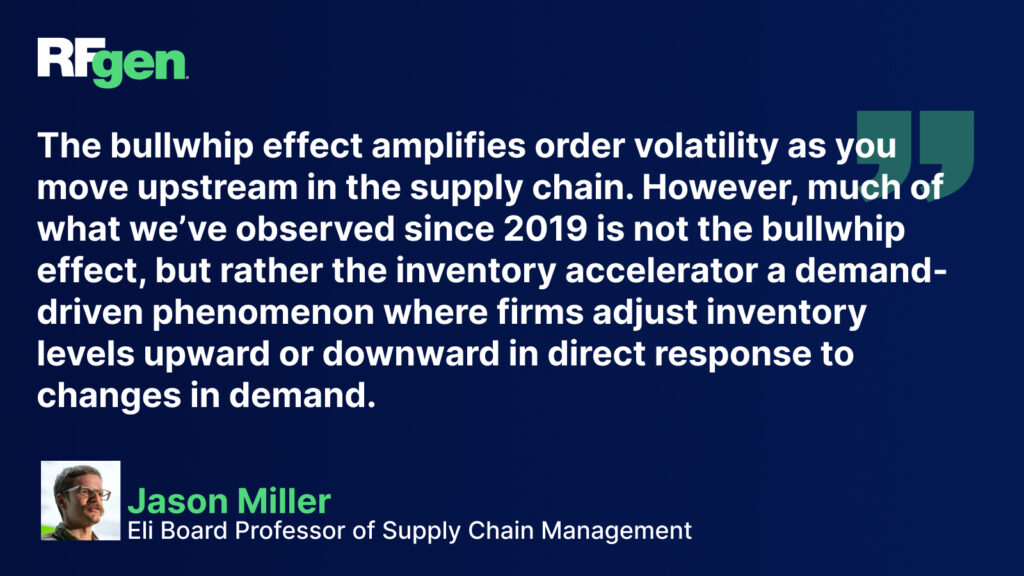Inventory Management Trends to Watch in 2025
- Data Collection
- Inventory Management Software
- Mobile Inventory Management

Imagine this: You’re a business owner staring at your latest inventory report. The numbers tell you inventory is up, but customer orders are down. What’s really going on? Is it a sudden shift in demand, a supply chain hiccup, or something else entirely? In today’s volatile market, understanding the forces driving inventory fluctuations is more critical than ever. The lingering effects of pandemic-related disruptions, coupled with unpredictable consumer behavior, have made inventory management a constant balancing act.
Traditional inventory reports, with their aggregated data and simplified trend lines, often obscure what’s happening beneath the surface. As Jason Miller, the Eli Broad Endowed Professor of Supply Chain Management at Michigan State University, points out, “Monthly and quarterly inventory reports tend to group all categories together… one trend line doesn’t always tell the full story.” This oversimplification can lead to misinterpretations and, ultimately, poor inventory decisions. You need to understand the why behind the numbers.
This post will explore the most important inventory management trends to watch in 2025. Drawing on Jason’s expert analysis, we’ll explain key concepts like the inventory accelerator and the bullwhip effect, providing clear definitions and real-world examples. We’ll also examine specific industry trends and offer practical guidance to help your business adapt and make data-driven decisions about inventory control.

Mastering Inventory in 2025: Key Trends Watch Webinar Now
WATCH WEBINAR »The Inventory Accelerator Effect
One of the most important concepts to grasp when it comes to understanding inventory fluctuations is the inventory accelerator. As Jason explains, “A firm’s level of inventory is positively correlated with its level of demand.” This means that as customer demand for a product increases, a business will typically increase its inventory levels to meet that demand. Conversely, when demand drops, inventory levels are adjusted downwards. This intuitive connection between demand and inventory levels is the core principle behind the inventory accelerator.
But the accelerator isn’t simply a one-to-one relationship. Jason points out that even basic inventory control mechanisms, like the Economic Order Quantity (EOQ), reflect this principle. “Your order quantity increases as demand goes up,” he notes, “but at a less than linear rate.” The same logic applies to safety stock: as demand rises, businesses hold more safety stock to buffer against potential disruptions, but this increase isn’t directly proportional to the rise in demand.
Understanding the nuances of the inventory accelerator is crucial for accurately interpreting inventory trends. A significant increase in inventory might not simply indicate overstocking; it could be a perfectly rational response to a surge in demand. Similarly, a decrease in inventory might not signify improved efficiency, but rather a contraction in customer orders.
In 2025, as businesses continue to grapple with volatile markets and shifting consumption patterns, the inventory accelerator will be a key factor to watch, influencing inventory decisions

The “bullwhip effect” is an often misunderstood concept frequently invoked when discussing inventory management, and it’s crucial to differentiate it from the inventory accelerator. Jason defines the bullwhip effect as the phenomenon where “the variance in orders tends to become more amplified as we move upstream in the supply chain.”
Think of it like this: a small ripple in consumer demand can create increasingly larger waves as it travels back through retailers, wholesalers, manufacturers, and suppliers. This amplification of order variability can lead to significant inefficiencies and inventory imbalances.
However, there is a key distinction: the bullwhip effect classically occurs under conditions of stationary demand. “The key idea with the bullwhip effect,”Jason explains, “is demand for that final good is stationary.” This means the average demand remains relatively constant over time. The bullwhip arises not from changes in actual consumption but from misinterpretations of demand signals and overreactions within the supply chain. He uses the example of diapers, a product with typically stable demand, to illustrate how even small variations can get magnified upstream.
Jason argues that much of the inventory volatility observed since 2019 is not a classic bullwhip effect. Why? Because demand itself has been anything but stationary. We’ve seen dramatic shifts in consumer spending, supply disruptions, and unprecedented market volatility. These fluctuations in actual demand, rather than simply the amplification of order variance, have been a primary driver of inventory imbalances.
In 2025, understanding this distinction will be essential. Businesses need to move beyond simplistic explanations and recognize the complex interplay of factors impacting their inventory levels.

Mastering the Art of Inventory: Unlocking Business Success with Accurate Management and Barcode Technology
READ NOW »Sector-Specific Trends and Insights
Analyzing inventory trends by sector offers a more granular understanding of the challenges and opportunities facing businesses in 2025. Jason’s analysis provides a valuable starting point, highlighting distinct patterns in key industries:
Machinery Wholesaling
This sector exemplifies the inventory accelerator effect in action, with periods of “sales rising really rapidly” followed by sharp drops. These fluctuations create a double benefit for manufacturers during upswings (increased sales and inventory replenishment) and a double punishment during downturns. Jason observes that inventories in this sector start to overshoot as sales fall, leading to excess stock.
For machinery wholesalers, 2025 will likely require a focus on balancing inventory levels with uncertain demand, potentially leveraging strategies like vendor-managed inventory (VMI) to share the risk with manufacturers.
Furniture Wholesalers
This sector mirrors the boom-and-bust cycle seen in machinery wholesaling. After an initial explosion of sales post-pandemic, furniture wholesalers saw demand decline, with sales falling “10 percent below pre-COVID levels.” Jason links this to broader economic trends, specifically the slowdown in the housing market and its impact on consumer spending.
For furniture wholesalers, 2025 presents the challenge of aligning inventory with potentially fluctuating demand in the housing sector. Strategies like just-in-time inventory and closer collaboration with retailers could prove essential.

Data Analytics: The Secret Ingredient to Efficient Inventory Management
READ NOW »Appliances, Electrical Equipment, and Electronic Goods
This sector’s robust performance, with sales “40 percent above pre-COVID levels,” is attributed to factors like the growth of solar energy (driving demand for solar panels) and the semiconductor boom. This sector includes companies like NVIDIA, whose graphic processing units are in high demand.
While the outlook for 2025 remains positive, Jason cautions against “excessive accumulation of inventories,” emphasizing the importance of managing growth effectively. Maintaining agility in the face of rapid technological advancements and potential supply chain disruptions will be key for businesses in this sector.
Apparel Wholesaling
This sector illustrates the challenges of adapting to shifting consumer preferences. After a post-pandemic rebound, apparel wholesalers saw sales fall sharply in 2023, leading to excess inventory. Jason emphasizes the importance of aligning stock with evolving consumer demand.
In 2025, apparel businesses must leverage data analytics and consumer insights to forecast trends more accurately and optimize their inventory accordingly. This may include techniques like micro-segmentation and personalized recommendations to better match supply with demand. Focusing on speed to market and efficient supply chains will also be crucial to responding to changing fashion trends.
Jason’s overarching observation about a return to pre-COVID inventory-to-sales ratios offers a crucial insight. While he acknowledges the “restocking narrative,” he concludes that excessive inventory accumulation is not the prevailing trend. He observes a “strong center of gravity back towards pre-COVID levels.” This suggests that in 2025, businesses across sectors will strive for more balanced inventory levels, recognizing the risks of both overstocking and understocking.

How to Achieve Flawless Fixed Asset Tracking with Mobile Barcoding
DOWNLOAD NOW »Conclusion
Understanding the nuances of the inventory accelerator and its distinction from the bullwhip effect is crucial for accurately interpreting inventory trends and making informed decisions. As we look ahead to 2025, businesses must move beyond simplistic explanations and embrace a more data-driven approach to inventory control. Sector-specific dynamics will continue to play a significant role, requiring tailored strategies that account for unique market conditions and demand patterns.
The projected return to pre-COVID inventory-to-sales ratios suggests a move towards greater balance, but the ability to adapt quickly to changing circumstances will be paramount. By leveraging advanced analytics, real-time data visibility, and flexible supply chain strategies, businesses can optimize their inventory levels, mitigate risks, and achieve sustainable growth in the years to come.
To learn more about the latest trends in inventory management watch the full webinar.




